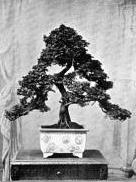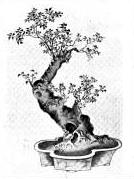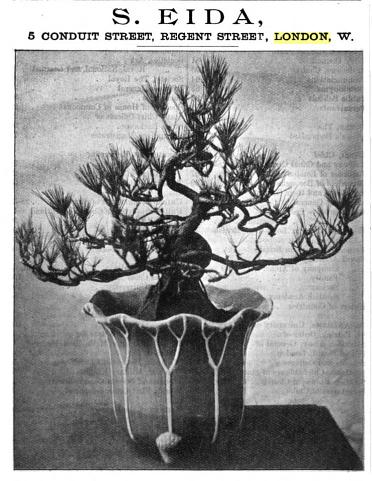
"Japanese Dwarf Thuja Tree, 150 years old."
|

"Japanese Dwarf Pine Tree, 25 years old." |
| Suburo Eida (fl. 1900-1910) was an importer and supplier of dwarf trees in the west-central London area. Some four or five hundred trees at a time, carefully packed in straw and typical Japanese bales,would be received by him to then be brought out of their dormancy. The following references supply our limited knowledge of this pioneer who was a Japanese Fellow of the Royal Horticultural Society. |

"Japanese Dwarf Thuja Tree, 150 years old."
|

"Japanese Dwarf Pine Tree, 25 years old." |
"Mention of Mr. Eida's Japanese dwarf trees and plants was made in
THE ART JOURNAL some time ago, and it is
interesting to notice that the appreciation of Japanese trees has so greatly developed that Mr. Eida has now to
keep a far larger stock of them owing to the increased demand. The dwellers in London and other large
towns have discovered that these beautiful little trees have a wonderful quality of resistance to the pernicious
conditions which surround flowers in our rooms. Instead of the perpetual attention and renewal which ordinary
ferns and plants require, these hardy little dwarf trees, in their quaint and picturesque pots, make small demand
on our time and care, and in the spring some are a mass of blossom, in the autumn others are covered with berries,
which will last a couple of years.
"Japanese Dwarf Maple Tree, 55 years old." "To our European minds the age of these trees appears unnatural, many being fifty, a hundred, or even two hundred years old. The imitation maple trees arc particularly attractive, with their young leaves of red and yellow, a contrast to the green of the older ones. The elms and beeches are also pleasing, and the dwarf firs most useful of all, with their everlasting green and bushy branches. The grey Japanese pots, ornamented with dark green and brown, tone in harmoniously with the grey green colour of the firs. The dwarf plants are being more and more used for table decoration; they are something new and make a change from the usual floral arrangements, which, lovely as they are, have not the novelty of these specially trained trees, the beauty of which grows the more one sees them. E. F. V." per The Art Journal (London: H. Virtue & Co., Ltd., 1900), Vol 62, pg. 350, paragraphs three through five under the heading "Industrial Art." The previous mention of Eida in this publication has not yet been located. In the 1900 edition of Who's Who (London: Adam & Charles Black), on pg. x can be found the following advertisement: 
Direct Importer of Japanese Objects of Art -- Genuine only.
At the Royal Horticultural Society's
Temple Show, May 22-24, "Mr. John Russell, of Richmond, showed a
large group of shrubs. All were well displayed, and comprised an interesting variety of things. We noticed especially Aralia
Maximowiczi, the Lilacs, Maples in full beauty, and represented by a choice selection of the best kinds, Wistarias in pots, and under the tree
and shrub groups Mr. Russell showed a collection of miniature Japanese trees, which seem to have become so popular during the past two or three
years... [xi] Japanese miniature trees came from Messrs. Barr and Sons, Covent Garden, and from Mr. S. Eida,
5, Conduit Street, Regent Street,"
per The Garden, Vol. LIX, No. 1540, May 25, 1901, pg.
384.
Speciality -- DWARF TREES AND SHRUBS. S. E I D A, 5 CONDUIT STREET, REGENT STREET, LONDON, W. "Mr. S. Eida, 5, Conduit Street, Regent Street, sent an interesting lot of dwarf Japanese trees... Messrs. Barr and Sons, Covent Garden, showed hardy flowers in great variety, including double and single Pæonies, Irises, Tritomas, Heucheras, Brodiæa laxa, Pentstemon acuminatus, Coreopsis, Gillenia trifoliata, Delphiniums. Pigmy Trees from Japan were also sent" for the non-competitive exhibits of the Richmond Horticultural Society on June 26, per The Garden, Vol. LIX, No. 1543, June 29, 1901, pg. 475. The exhibitors of clipped trees [at the 1902 Temple Show] had this year to compete against others showing specimens of the Japanese dwarfed trees, and between them they were very curiously inspected by a large proportion of the visitors. The largest collection of clipped trees, representing animals, birds, and objects, was again shown by Messrs. W. CUTBUSH & SON, Highgate Nurseries, London, and a very representative lot they were. Of the Japanese type, which are merely dwarfed or "nanized," the largest collection came from Messrs. BARR & SONS, King Street, Covent Garden, London, who built a neat tent in which to display the plants. Messrs. JAS. CARTER & CO., High Holhorn, London, had also a moderate-sized collection in a kind of annexe[sic] to one of the tents. Another exhibit of the same type was from Mr. S. EIDA, 5, Conduit Street. Regent Street, W," per The Gardeners' Chronicle, Vol. XXXI, No. 805, May 31, 1902, pg. 361. The Garden, May 31, 1902, in an article listing awards given at the recent Temple Show, mentions that a Silver Flora Medal was given to Mr. S. Eida for dwarf trees, pg. ix. (The Gardeners' Chronicle for May 31, 1902, pg. 363 listed the winner as "P. Eida.") "The fourteenth annual flower show of the Cardiff and District Horticultural Society was held on [July 23 and 24, 1902] in the Sophia Gardens, in beautiful weather.... A centre of attraction was a collection of Japanese Dwarf Trees shown by Mr. Eida, of London, which was one of the chief novelties of the show..." "[110]...In the non-competitive section, A. E. Price, of Cardiff, contributed Sweet Peas in vases; while Gold Medals were awarded to Mr. J. Russell, Richmond, Surrey; and Mrs. S. Eida, Conduit Street, London," per Journal of horticulture, cottage gardener and home farmer, Vol. 45, July 31, 1902, pg. 109-110. China and Japan. The names of each of the 235 guests were written upon cards emblazoned with the Japanese Service flag..." per the Anglo-Japanese gazette, Vol. II, No. II, May 1903, pg. 99. "Two separate acres in different parts of the exhibition will be converted, under 100 and more British workmen, into Japanese landscape gardens, representing two of the seven styles or schools prevailing in Japan. On one site the S-shaped lake is already excavated, and the 16ft. hill is rising. Quaint stringed and pegged patterns are dotted over the greass and the structure of the bridges -- one over a railway; the others over the lake are mapped out. "On this acre a whole countryside will be represented; a high waterfall, lakes, hills, trees, grass flowers, with many other features. The iris and the lotus lake are side by side; and the supreme glory will be the wistarias, some dwarf trees covered with bloom, some wide and spreading. All plants will come direct from Japan; the lotus plants and irises and 16ft maples, as well as the 200-year-old dwarf trees, the stones, and the 300-year-old stone lantern towers, with every bit of lichenous and mossy growth carefully protected. The flowers are coming by way of America, for fear that the heat of the other route should make the lotus and irises flower prematurely. "A miniature garden, 12ft. by 7ft. -- designed by the famous Taikoyen -- is to be exhibited; but Mr. Izawa and Mr. Eida rely on the bigger gardens to convert English people to the Japanese style. There is an additional reference to Eida made in Queensland agricultural journal, Vol 24, May 1910, under "Answers to Correspondents," pg. 245, entitled "DWARFING FRUIT TREES:" "'ORCHARDIST,' Blackall Range.-- "The method of dwarfing fruit trees is kept secret by the Japanese, but a Japanese garden artst, Mr. Suburo Eida, has explained some of the secrets of culture at the coming Shepherd's Bush (England) Exhibition. There will be some dwarf Wistarias covered with bloom, and 200 years old. Mr. Eida said that the secret of dwarfing was continual labour along the following lines:--After some years' growth the taproot is cut; then, every year, the tree is repotted, with necessary root trimmings; and, for the rest, growth is arrested by continually changing the tree from dark rooms to light rooms and from cold to hot, with immense care in supplying the exact amount of water. "We cannot understand how an orange-tree can be dwarfed as we have seen it, after several years' growth, for the tree in six years would be 8 or 10 ft. high, so the secret is still a secret, notwithstanding Mr. Eida's explanation." |
|
Other Mentions of Mr. Eida on This Web Site include: Per The Gardeners' Chronicle, No. 961, June 3, 1905, pg. 350, At the Temple Show of the Royal Botanic Society, "Miniature trees from China and Japan were on show from Messrs. BARR & SONS, King Street, Covent Garden; and Messrs. CARTER & CO., seedsmen, High Holborn. Per The Gardeners' Chronicle, No. 962, June 10, 1905, pg. 366, At the summer horticultural exhibition of the Royal Botanic Society on June 7-9, 1905, "Messrs. BARR & SONS, King Street, Covent Garden, London, exhibited a large display of hardy flowers, including Lupines, Irises, Pæonies, Gladioli, Poppies, Pyrethrums, &c. On the opposite table Messrs. BARR displayed a large collection of dwarf trees in fancy china pots (Gold Medal)." |